Research Proposal: Social Media Marketing's Impact on Loyalty
VerifiedAdded on 2022/11/23
|7
|1150
|252
Report
AI Summary
This research proposal aims to examine the influence of social media marketing on consumer shopping habits and brand loyalty. The objectives include specifying how customer attitudes are affected by social media influencers, determining key demographics for social media platforms as target markets, and understanding the relationship between social media and customer attitude. The methodology employs a deductive approach, descriptive research design, and a combination of qualitative and quantitative research methods. The study will use quantitative data from a sample of 250 participants, analyzed using statistical software, while qualitative data will be analyzed by understanding records and searching for similarities and differences. Ethical considerations include respecting autonomy, privacy, dignity, scientific integrity, and social responsibility. The proposal also addresses maximizing benefits and minimizing harm to participants.
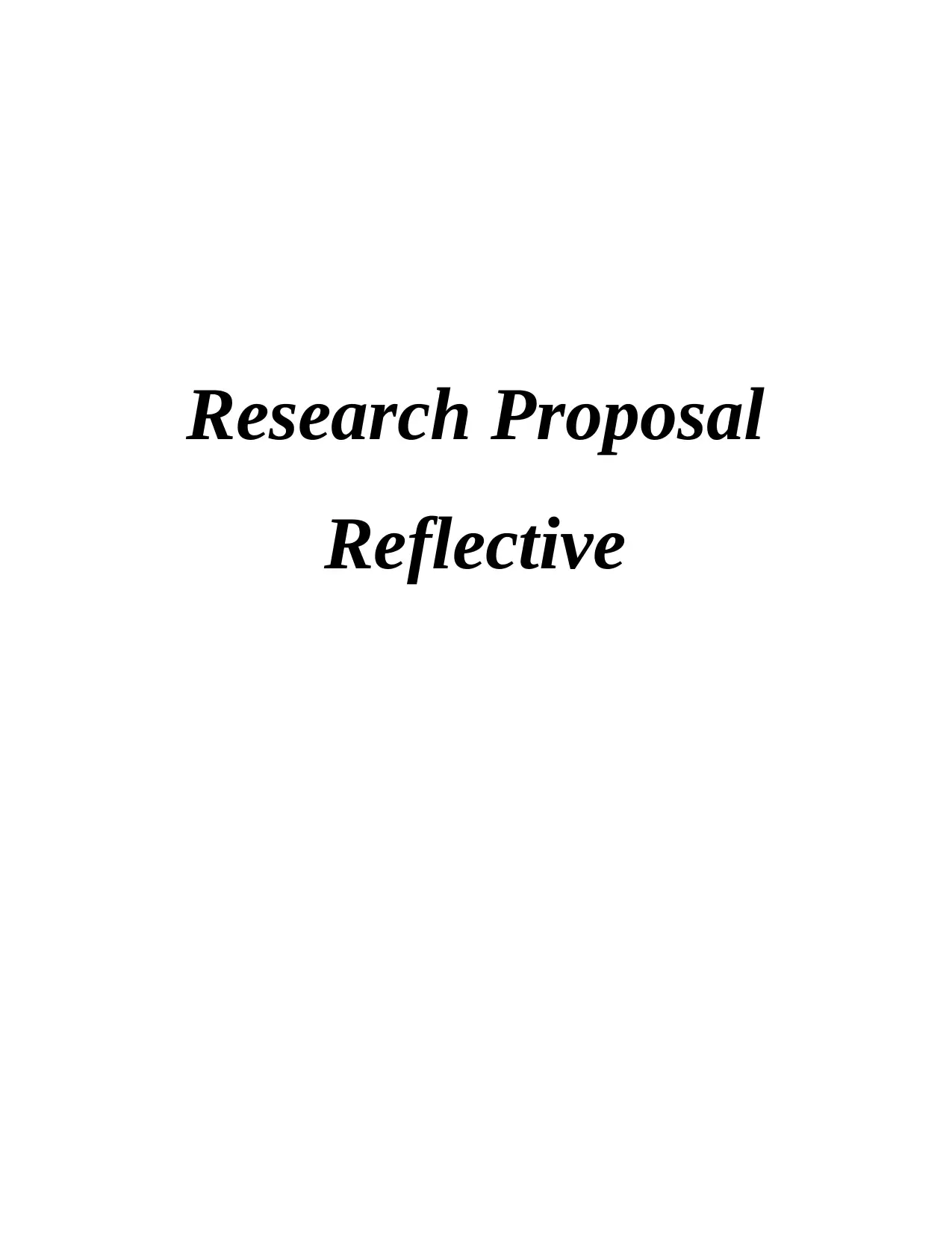
Research Proposal
Reflective
Reflective
Paraphrase This Document
Need a fresh take? Get an instant paraphrase of this document with our AI Paraphraser
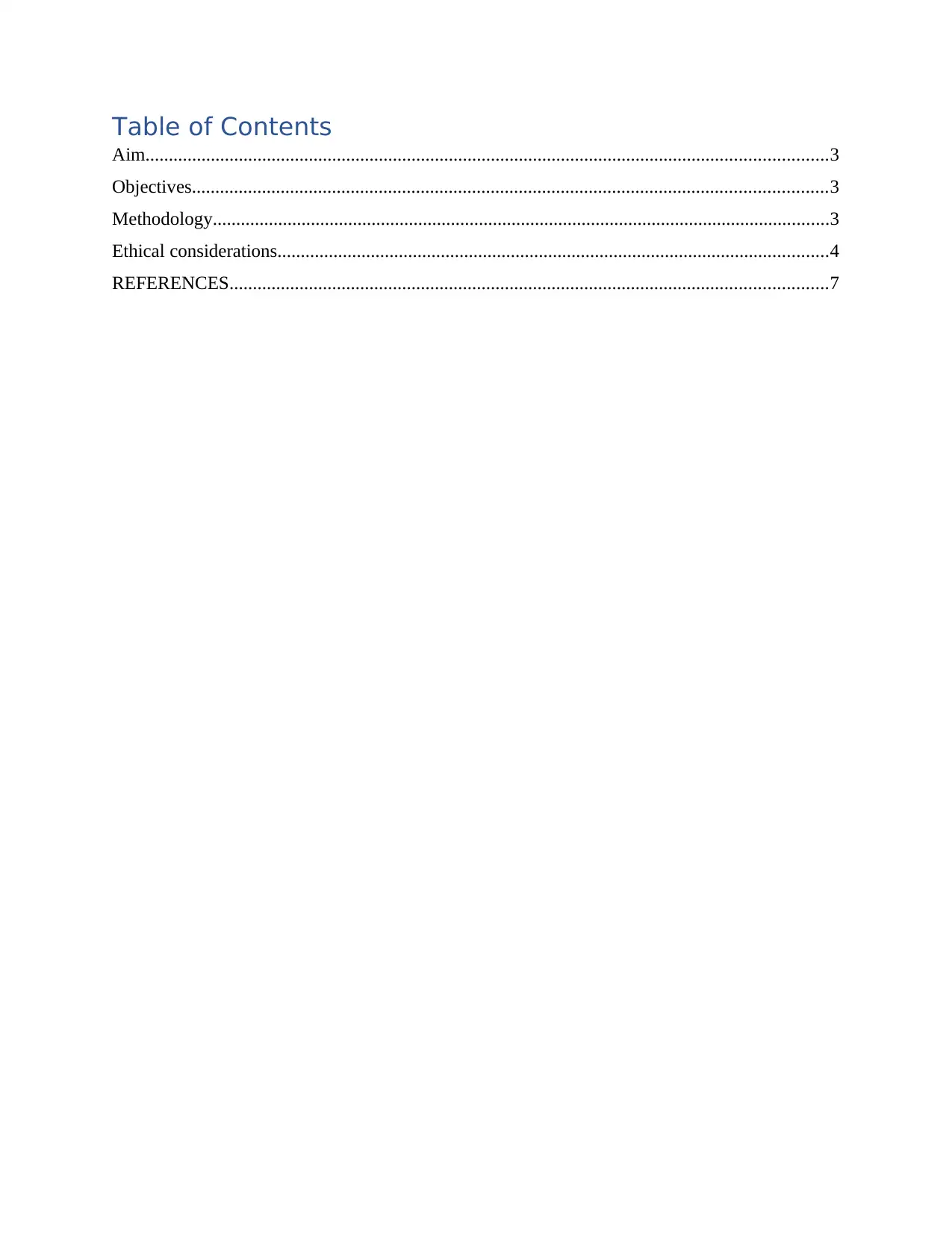
Table of Contents
Aim..................................................................................................................................................3
Objectives........................................................................................................................................3
Methodology....................................................................................................................................3
Ethical considerations......................................................................................................................4
REFERENCES................................................................................................................................7
Aim..................................................................................................................................................3
Objectives........................................................................................................................................3
Methodology....................................................................................................................................3
Ethical considerations......................................................................................................................4
REFERENCES................................................................................................................................7
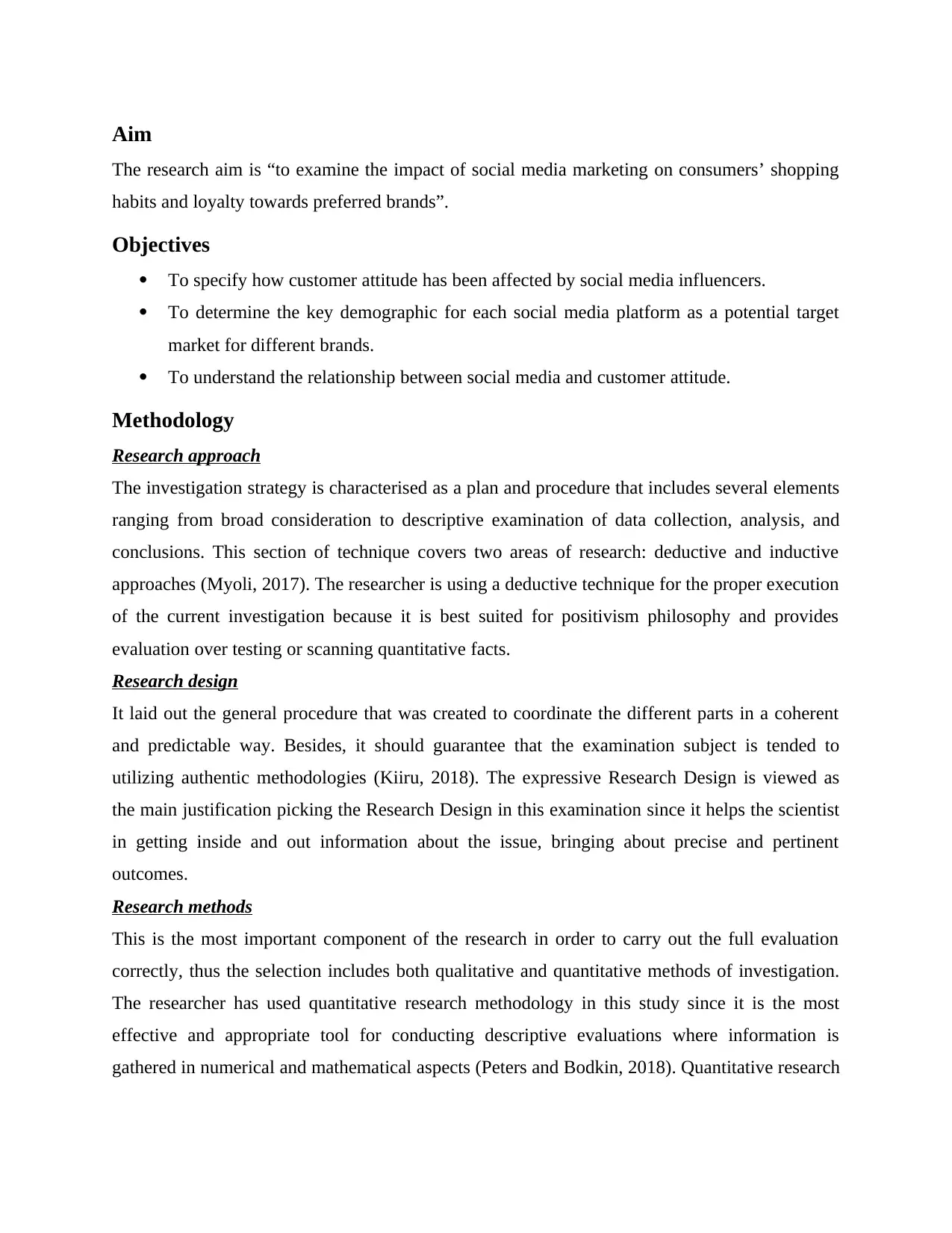
Aim
The research aim is “to examine the impact of social media marketing on consumers’ shopping
habits and loyalty towards preferred brands”.
Objectives
To specify how customer attitude has been affected by social media influencers.
To determine the key demographic for each social media platform as a potential target
market for different brands.
To understand the relationship between social media and customer attitude.
Methodology
Research approach
The investigation strategy is characterised as a plan and procedure that includes several elements
ranging from broad consideration to descriptive examination of data collection, analysis, and
conclusions. This section of technique covers two areas of research: deductive and inductive
approaches (Myoli, 2017). The researcher is using a deductive technique for the proper execution
of the current investigation because it is best suited for positivism philosophy and provides
evaluation over testing or scanning quantitative facts.
Research design
It laid out the general procedure that was created to coordinate the different parts in a coherent
and predictable way. Besides, it should guarantee that the examination subject is tended to
utilizing authentic methodologies (Kiiru, 2018). The expressive Research Design is viewed as
the main justification picking the Research Design in this examination since it helps the scientist
in getting inside and out information about the issue, bringing about precise and pertinent
outcomes.
Research methods
This is the most important component of the research in order to carry out the full evaluation
correctly, thus the selection includes both qualitative and quantitative methods of investigation.
The researcher has used quantitative research methodology in this study since it is the most
effective and appropriate tool for conducting descriptive evaluations where information is
gathered in numerical and mathematical aspects (Peters and Bodkin, 2018). Quantitative research
The research aim is “to examine the impact of social media marketing on consumers’ shopping
habits and loyalty towards preferred brands”.
Objectives
To specify how customer attitude has been affected by social media influencers.
To determine the key demographic for each social media platform as a potential target
market for different brands.
To understand the relationship between social media and customer attitude.
Methodology
Research approach
The investigation strategy is characterised as a plan and procedure that includes several elements
ranging from broad consideration to descriptive examination of data collection, analysis, and
conclusions. This section of technique covers two areas of research: deductive and inductive
approaches (Myoli, 2017). The researcher is using a deductive technique for the proper execution
of the current investigation because it is best suited for positivism philosophy and provides
evaluation over testing or scanning quantitative facts.
Research design
It laid out the general procedure that was created to coordinate the different parts in a coherent
and predictable way. Besides, it should guarantee that the examination subject is tended to
utilizing authentic methodologies (Kiiru, 2018). The expressive Research Design is viewed as
the main justification picking the Research Design in this examination since it helps the scientist
in getting inside and out information about the issue, bringing about precise and pertinent
outcomes.
Research methods
This is the most important component of the research in order to carry out the full evaluation
correctly, thus the selection includes both qualitative and quantitative methods of investigation.
The researcher has used quantitative research methodology in this study since it is the most
effective and appropriate tool for conducting descriptive evaluations where information is
gathered in numerical and mathematical aspects (Peters and Bodkin, 2018). Quantitative research
⊘ This is a preview!⊘
Do you want full access?
Subscribe today to unlock all pages.

Trusted by 1+ million students worldwide
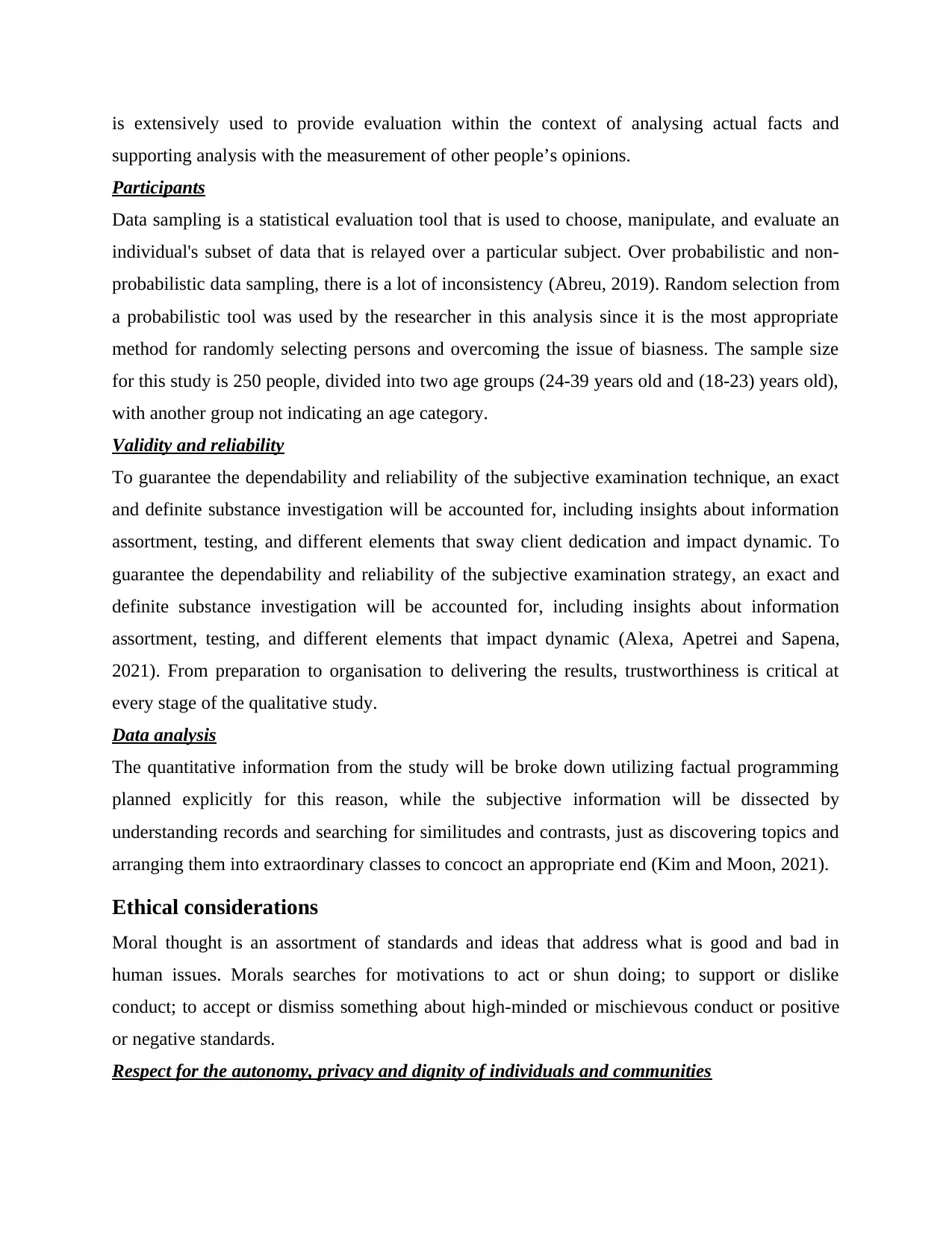
is extensively used to provide evaluation within the context of analysing actual facts and
supporting analysis with the measurement of other people’s opinions.
Participants
Data sampling is a statistical evaluation tool that is used to choose, manipulate, and evaluate an
individual's subset of data that is relayed over a particular subject. Over probabilistic and non-
probabilistic data sampling, there is a lot of inconsistency (Abreu, 2019). Random selection from
a probabilistic tool was used by the researcher in this analysis since it is the most appropriate
method for randomly selecting persons and overcoming the issue of biasness. The sample size
for this study is 250 people, divided into two age groups (24-39 years old and (18-23) years old),
with another group not indicating an age category.
Validity and reliability
To guarantee the dependability and reliability of the subjective examination technique, an exact
and definite substance investigation will be accounted for, including insights about information
assortment, testing, and different elements that sway client dedication and impact dynamic. To
guarantee the dependability and reliability of the subjective examination strategy, an exact and
definite substance investigation will be accounted for, including insights about information
assortment, testing, and different elements that impact dynamic (Alexa, Apetrei and Sapena,
2021). From preparation to organisation to delivering the results, trustworthiness is critical at
every stage of the qualitative study.
Data analysis
The quantitative information from the study will be broke down utilizing factual programming
planned explicitly for this reason, while the subjective information will be dissected by
understanding records and searching for similitudes and contrasts, just as discovering topics and
arranging them into extraordinary classes to concoct an appropriate end (Kim and Moon, 2021).
Ethical considerations
Moral thought is an assortment of standards and ideas that address what is good and bad in
human issues. Morals searches for motivations to act or shun doing; to support or dislike
conduct; to accept or dismiss something about high-minded or mischievous conduct or positive
or negative standards.
Respect for the autonomy, privacy and dignity of individuals and communities
supporting analysis with the measurement of other people’s opinions.
Participants
Data sampling is a statistical evaluation tool that is used to choose, manipulate, and evaluate an
individual's subset of data that is relayed over a particular subject. Over probabilistic and non-
probabilistic data sampling, there is a lot of inconsistency (Abreu, 2019). Random selection from
a probabilistic tool was used by the researcher in this analysis since it is the most appropriate
method for randomly selecting persons and overcoming the issue of biasness. The sample size
for this study is 250 people, divided into two age groups (24-39 years old and (18-23) years old),
with another group not indicating an age category.
Validity and reliability
To guarantee the dependability and reliability of the subjective examination technique, an exact
and definite substance investigation will be accounted for, including insights about information
assortment, testing, and different elements that sway client dedication and impact dynamic. To
guarantee the dependability and reliability of the subjective examination strategy, an exact and
definite substance investigation will be accounted for, including insights about information
assortment, testing, and different elements that impact dynamic (Alexa, Apetrei and Sapena,
2021). From preparation to organisation to delivering the results, trustworthiness is critical at
every stage of the qualitative study.
Data analysis
The quantitative information from the study will be broke down utilizing factual programming
planned explicitly for this reason, while the subjective information will be dissected by
understanding records and searching for similitudes and contrasts, just as discovering topics and
arranging them into extraordinary classes to concoct an appropriate end (Kim and Moon, 2021).
Ethical considerations
Moral thought is an assortment of standards and ideas that address what is good and bad in
human issues. Morals searches for motivations to act or shun doing; to support or dislike
conduct; to accept or dismiss something about high-minded or mischievous conduct or positive
or negative standards.
Respect for the autonomy, privacy and dignity of individuals and communities
Paraphrase This Document
Need a fresh take? Get an instant paraphrase of this document with our AI Paraphraser
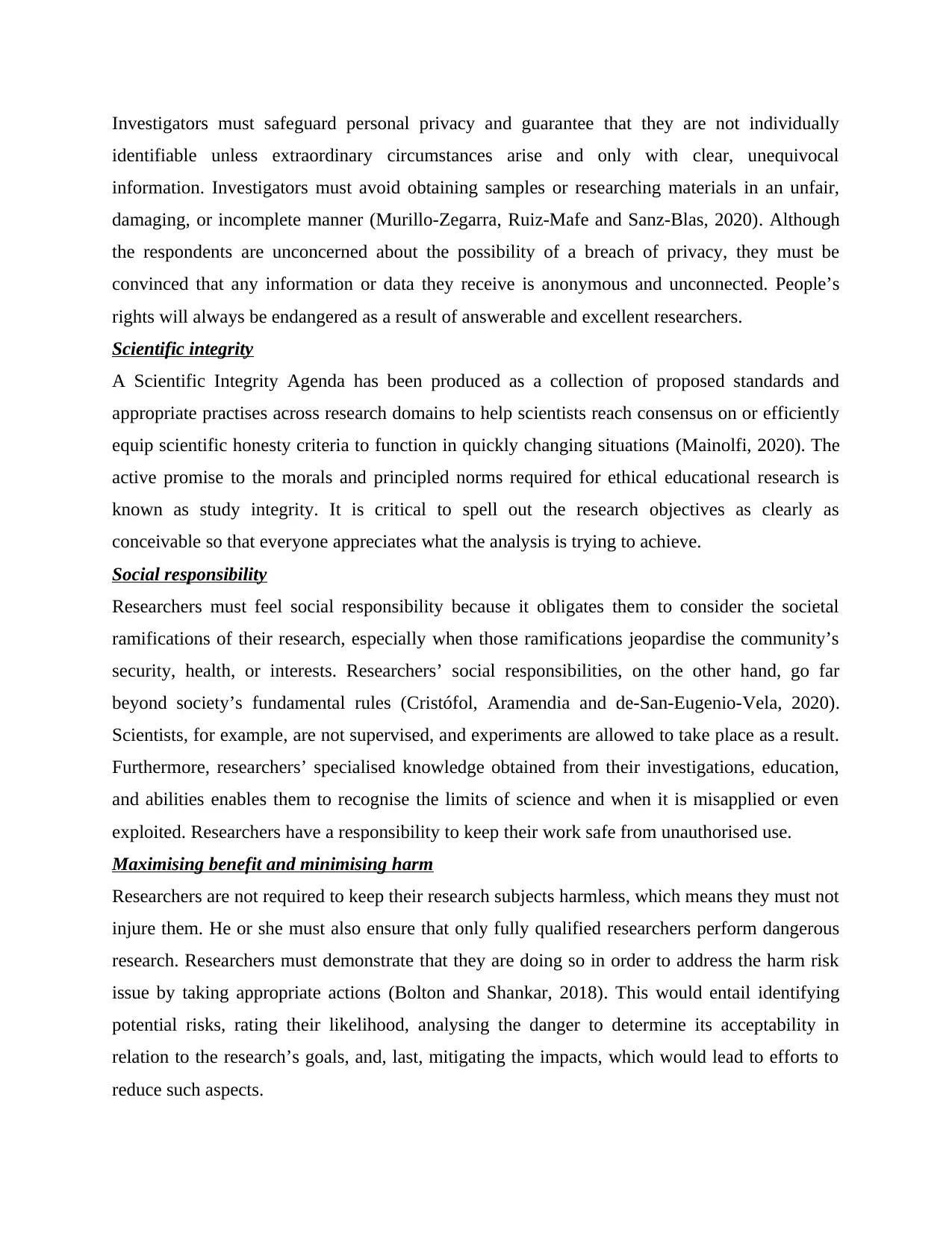
Investigators must safeguard personal privacy and guarantee that they are not individually
identifiable unless extraordinary circumstances arise and only with clear, unequivocal
information. Investigators must avoid obtaining samples or researching materials in an unfair,
damaging, or incomplete manner (Murillo-Zegarra, Ruiz-Mafe and Sanz-Blas, 2020). Although
the respondents are unconcerned about the possibility of a breach of privacy, they must be
convinced that any information or data they receive is anonymous and unconnected. People’s
rights will always be endangered as a result of answerable and excellent researchers.
Scientific integrity
A Scientific Integrity Agenda has been produced as a collection of proposed standards and
appropriate practises across research domains to help scientists reach consensus on or efficiently
equip scientific honesty criteria to function in quickly changing situations (Mainolfi, 2020). The
active promise to the morals and principled norms required for ethical educational research is
known as study integrity. It is critical to spell out the research objectives as clearly as
conceivable so that everyone appreciates what the analysis is trying to achieve.
Social responsibility
Researchers must feel social responsibility because it obligates them to consider the societal
ramifications of their research, especially when those ramifications jeopardise the community’s
security, health, or interests. Researchers’ social responsibilities, on the other hand, go far
beyond society’s fundamental rules (Cristófol, Aramendia and de-San-Eugenio-Vela, 2020).
Scientists, for example, are not supervised, and experiments are allowed to take place as a result.
Furthermore, researchers’ specialised knowledge obtained from their investigations, education,
and abilities enables them to recognise the limits of science and when it is misapplied or even
exploited. Researchers have a responsibility to keep their work safe from unauthorised use.
Maximising benefit and minimising harm
Researchers are not required to keep their research subjects harmless, which means they must not
injure them. He or she must also ensure that only fully qualified researchers perform dangerous
research. Researchers must demonstrate that they are doing so in order to address the harm risk
issue by taking appropriate actions (Bolton and Shankar, 2018). This would entail identifying
potential risks, rating their likelihood, analysing the danger to determine its acceptability in
relation to the research’s goals, and, last, mitigating the impacts, which would lead to efforts to
reduce such aspects.
identifiable unless extraordinary circumstances arise and only with clear, unequivocal
information. Investigators must avoid obtaining samples or researching materials in an unfair,
damaging, or incomplete manner (Murillo-Zegarra, Ruiz-Mafe and Sanz-Blas, 2020). Although
the respondents are unconcerned about the possibility of a breach of privacy, they must be
convinced that any information or data they receive is anonymous and unconnected. People’s
rights will always be endangered as a result of answerable and excellent researchers.
Scientific integrity
A Scientific Integrity Agenda has been produced as a collection of proposed standards and
appropriate practises across research domains to help scientists reach consensus on or efficiently
equip scientific honesty criteria to function in quickly changing situations (Mainolfi, 2020). The
active promise to the morals and principled norms required for ethical educational research is
known as study integrity. It is critical to spell out the research objectives as clearly as
conceivable so that everyone appreciates what the analysis is trying to achieve.
Social responsibility
Researchers must feel social responsibility because it obligates them to consider the societal
ramifications of their research, especially when those ramifications jeopardise the community’s
security, health, or interests. Researchers’ social responsibilities, on the other hand, go far
beyond society’s fundamental rules (Cristófol, Aramendia and de-San-Eugenio-Vela, 2020).
Scientists, for example, are not supervised, and experiments are allowed to take place as a result.
Furthermore, researchers’ specialised knowledge obtained from their investigations, education,
and abilities enables them to recognise the limits of science and when it is misapplied or even
exploited. Researchers have a responsibility to keep their work safe from unauthorised use.
Maximising benefit and minimising harm
Researchers are not required to keep their research subjects harmless, which means they must not
injure them. He or she must also ensure that only fully qualified researchers perform dangerous
research. Researchers must demonstrate that they are doing so in order to address the harm risk
issue by taking appropriate actions (Bolton and Shankar, 2018). This would entail identifying
potential risks, rating their likelihood, analysing the danger to determine its acceptability in
relation to the research’s goals, and, last, mitigating the impacts, which would lead to efforts to
reduce such aspects.

⊘ This is a preview!⊘
Do you want full access?
Subscribe today to unlock all pages.

Trusted by 1+ million students worldwide
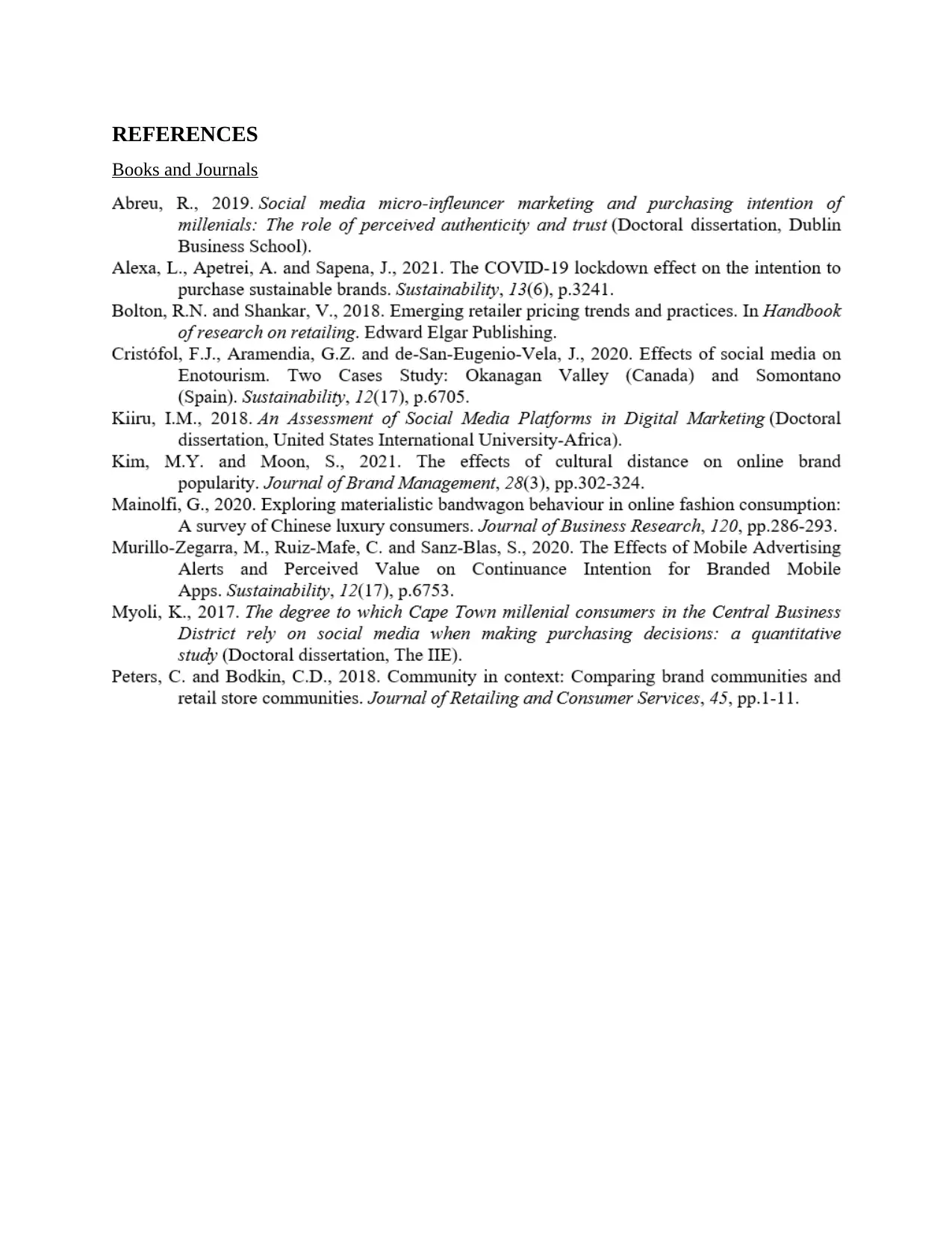
REFERENCES
Books and Journals
Books and Journals
1 out of 7
Related Documents
Your All-in-One AI-Powered Toolkit for Academic Success.
+13062052269
info@desklib.com
Available 24*7 on WhatsApp / Email
![[object Object]](/_next/static/media/star-bottom.7253800d.svg)
Unlock your academic potential
Copyright © 2020–2025 A2Z Services. All Rights Reserved. Developed and managed by ZUCOL.





